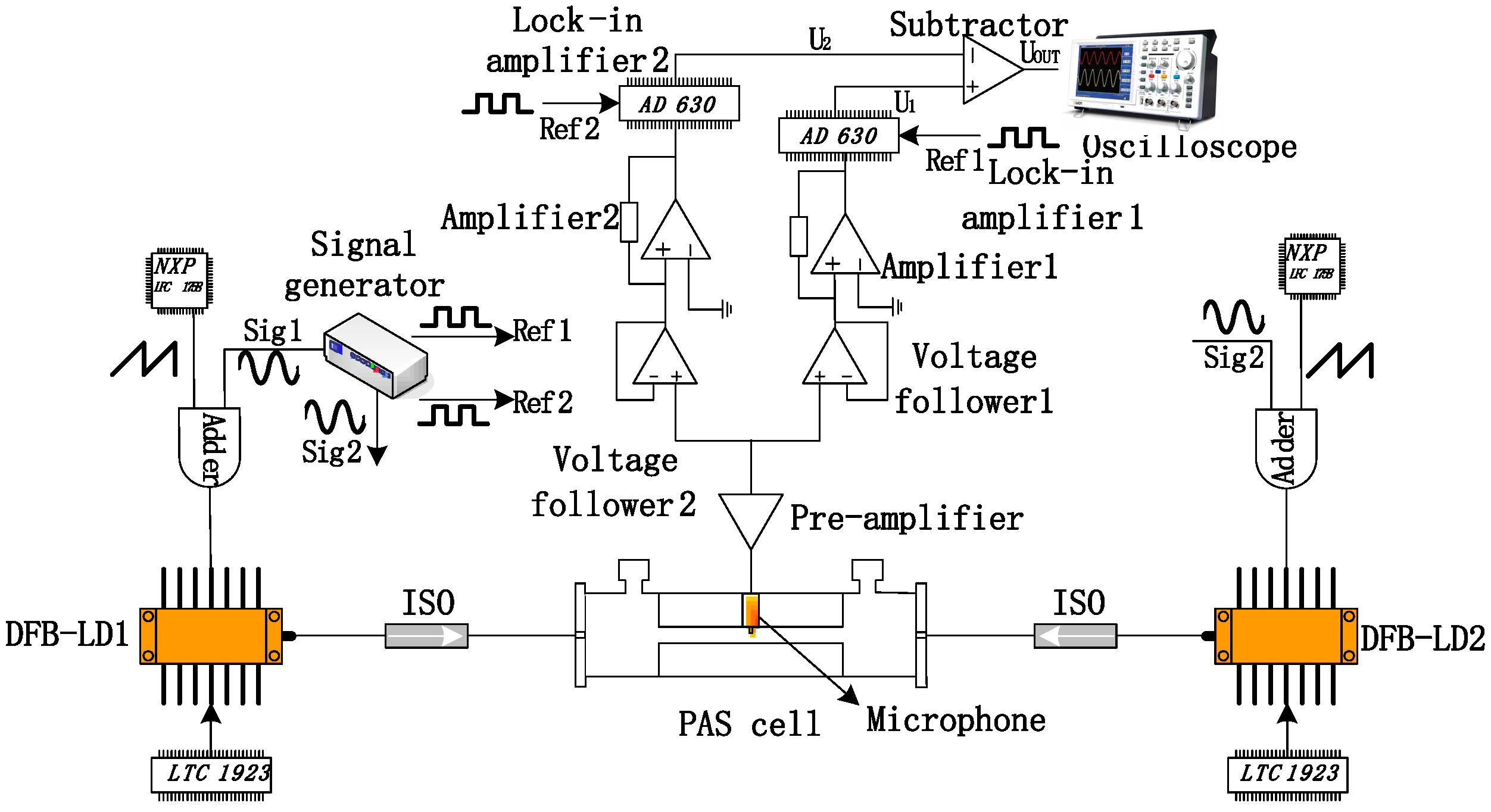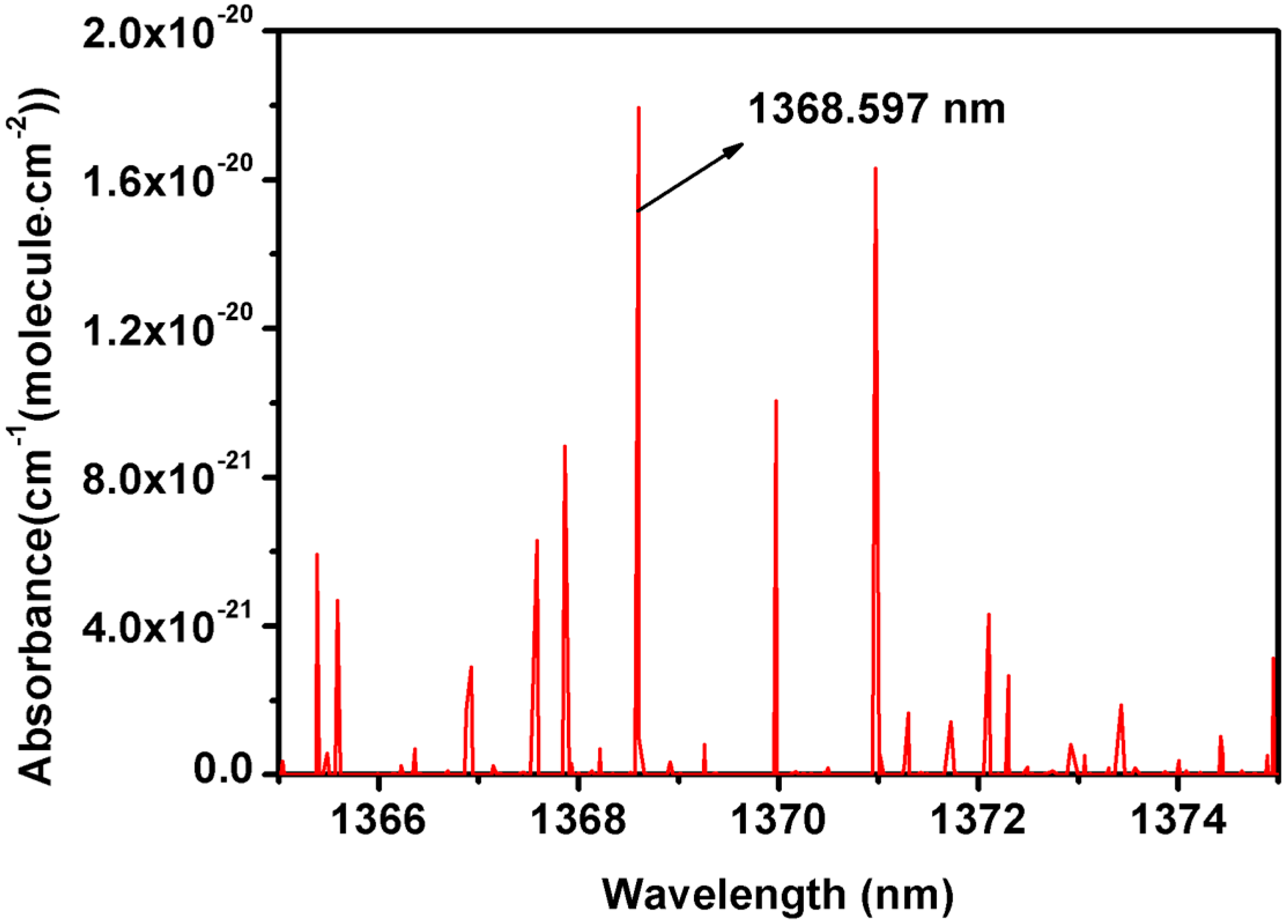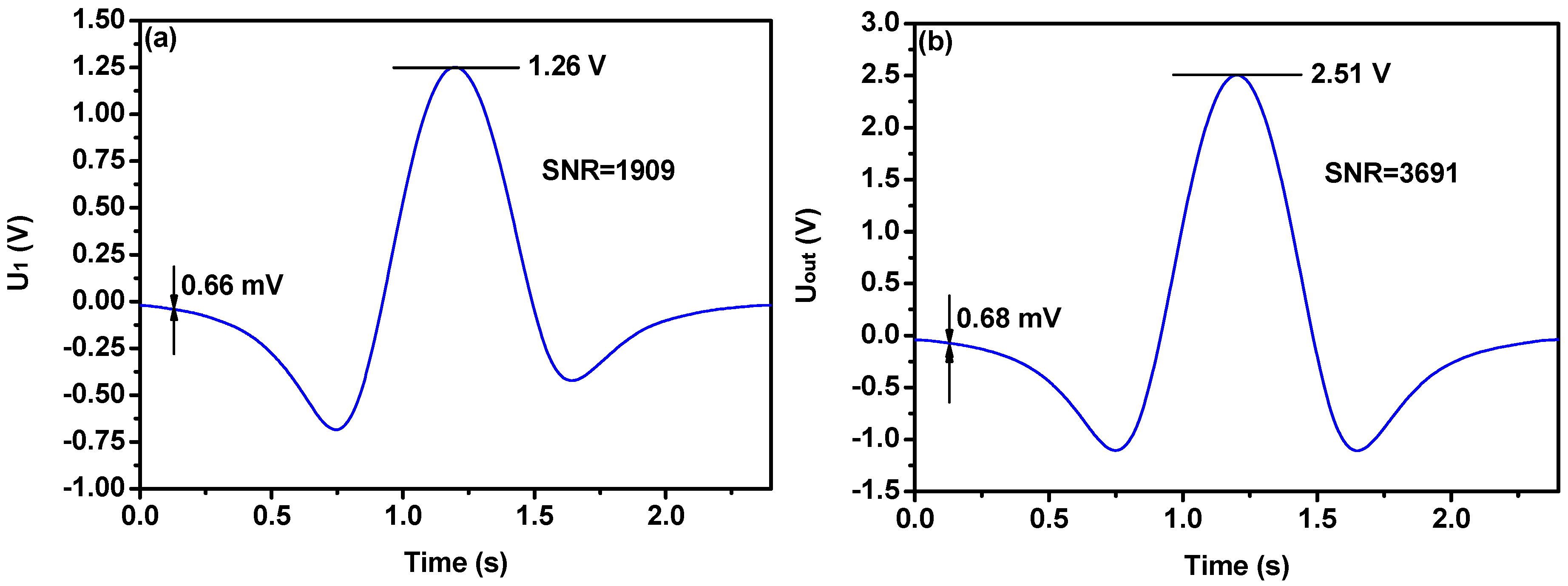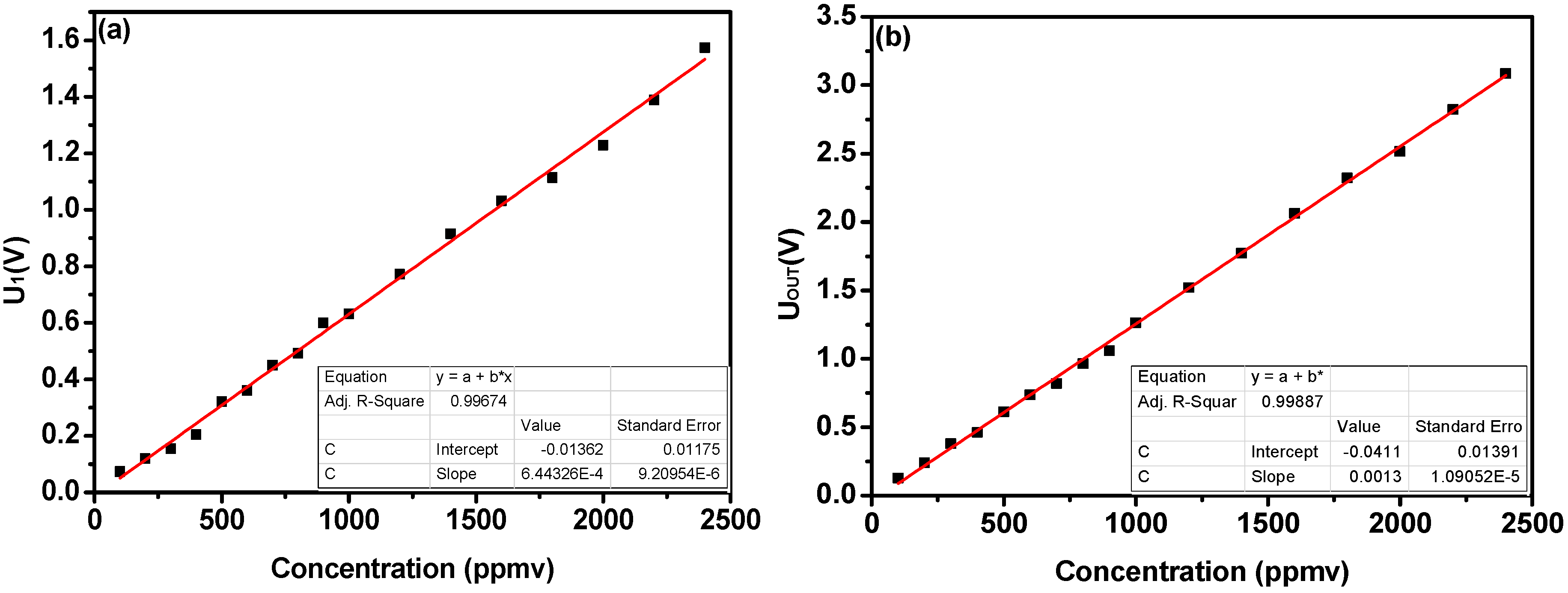Dual Path Lock-In System for Elimination of Residual Amplitude Modulation and SNR Enhancement in Photoacoustic Spectroscopy
Abstract
1. Introduction
2. Theory Analysis
2.1. ERAM Theory
2.2. SNR Enhancement Theory
3. Presentation of Experimental Setup
4. Experimental Verification
4.1. Elimination of Residual Amplitude Modulation
4.2. SNR Enhancement
4.3. Linearity and Long-Term Stability in Water Vapor Detection
5. Conclusions
Author Contributions
Funding
Conflicts of Interest
References
- Gong, Z.; Chen, K.; Yang, Y.; Zhou, X.; Peng, W.; Yu, Q. High-sensitivity fiber-optic acoustic sensor for photoacoustic spectroscopy based traces gas detection. Sens. Actuators B Chem. 2017, 247, 290–295. [Google Scholar] [CrossRef]
- Wu, H.; Dong, L.; Zheng, H.; Yu, Y.; Ma, W.; Zhang, L.; Yin, W.; Xiao, L.; Jia, S.; Tittel, F.K. Beat frequency quartz-enhanced photoacoustic spectroscopy for fast and calibration-free continuous trace-gas monitoring. Nat. Commun. 2017, 8, 15331. [Google Scholar] [CrossRef] [PubMed]
- Meyer, P.L.; Sigrist, M.W. Atmospheric pollution monitoring using CO2-laser photoacoustic spectroscopy and other techniques. Rev. Sci. Instrum. 1990, 61, 1779–1807. [Google Scholar] [CrossRef]
- Zheng, H.; Lou, M.; Dong, L.; Wu, H.; Ye, W.; Yin, X.; Kim, C.S.; Kim, M.; Bewley, W.W.; Merritt, C.D.; et al. Compact photoacoustic module for methane detection incorporating interband cascade light emitting device. Opt. Express 2017, 25, 16761–16770. [Google Scholar] [CrossRef] [PubMed]
- Zhang, Q.; Chang, J.; Wang, Q.; Wang, Z.; Wang, F.; Qin, Z. Acousto-Optic Q-Switched Fiber Laser-Based Intra-Cavity Photoacoustic Spectroscopy for Trace Gas Detection. Sensors 2018, 18, 42. [Google Scholar] [CrossRef] [PubMed]
- Zhang, Q.; Chang, J.; Wang, F.; Wang, Z.; Xie, Y.; Gong, W. Improvement in QEPAS system utilizing a second harmonic based wavelength calibration technique. Opt. Commun. 2018, 415, 25–30. [Google Scholar] [CrossRef]
- Kluczynski, P.; Axner, O. Theoretical description based on Fourier analysis of wavelength-modulation spectrometry in terms of analytical and background signals. Appl. Opt. 1999, 38, 5803–5815. [Google Scholar] [CrossRef]
- Wei, W.; Chang, J.; Wang, Q.; Qin, Z. Modulation Index Adjustment for Recovery of Pure Wavelength Modulation Spectroscopy Second Harmonic Signal Waveforms. Sensors 2017, 17, 163. [Google Scholar] [CrossRef]
- Chakraborty, A.L.; Ruxton, K.; Johnstone, W.; Lengden, M.; Duffin, K. Elimination of residual amplitude modulation in tunable diode laser wavelength modulation spectroscopy using an optical fiber delay line. Opt. Express 2009, 17, 9602–9607. [Google Scholar] [CrossRef]
- De Tommasi, E.; Casa, G.; Gianfrani, L. An intensity-stabilized diode-laser spectrometer for sensitive detection of NH3. IEEE Trans Instrum. Meas. 2007, 56, 309–312. [Google Scholar] [CrossRef]
- Zhu, C.; Chang, J.; Wang, P.; Wei, W.; Wang, Q.; Wang, F.; Zhang, S. Continuously Wavelength-Tunable Light Source With Constant-Power Output for Elimination of Residual Amplitude Modulation. IEEE Sens. J. 2015, 15, 316–321. [Google Scholar] [CrossRef]
- Wang, Q.; Wang, Z.; Chang, J.; Ren, W. Fiber-ring laser-based intracavity photoacoustic spectroscopy for trace gas sensing. Opt. Lett. 2017, 42, 2114–2117. [Google Scholar] [CrossRef]
- Ma, Y.; He, Y.; Zhang, L.; Yu, X.; Zhang, J.; Sun, R.; Tittel, F.K. Ultra-high sensitive acetylene detection using quartz-enhanced photoacoustic spectroscopy with a fiber amplified diode laser and a 30.72 kHz quartz tuning fork. Appl. Phys. Lett. 2017, 110, 031107. [Google Scholar] [CrossRef]
- Liu, Y.; Chang, J.; Lian, J.; Liu, Z.; Wang, Q.; Qin, Z. Quartz-Enhanced Photoacoustic Spectroscopy with Right-Angle Prism. Sensors 2016, 16, 214. [Google Scholar] [CrossRef] [PubMed]
- Macias-Bobadilla, G.; Rodriguez-Resendiz, J.; Mota-Valtierra, G.; Soto-Zarazua, G.; Mendez-Loyola, M.; Garduno-Aparicio, M. Dual-Phase Lock-In Amplifier Based on FPGA for Low-Frequencies Experiments. Sensors 2016, 16, 379. [Google Scholar] [CrossRef]
- Abitan, H.; Bohr, H.; Buchhave, P. Correction to the Beer-Lambert-Bouguer law for optical absorption. Appl. Opt. 2008, 47, 5354–5357. [Google Scholar] [CrossRef] [PubMed]
- Liu, Y.; Chang, J.; Lian, J.; Liu, Z.; Wang, Q.; Zhu, C. A Time Difference Method for Measurement of Phase Shift between Distributed Feedback Laser Diode (DFB-LD) Output Wavelength and Intensity. Sensors 2015, 15, 16153–16161. [Google Scholar] [CrossRef]
- Rothman, L.S.; Gordon, I.E.; Babikov, Y.; Barbe, A.; Benner, D.C.; Bernath, P.F.; Birk, M.; Bizzocchi, L.; Boudon, V.; Brown, L.R.; et al. The HITRAN2012 molecular spectroscopic database. J. Quant. Spectrosc. Radiat. Transf. 2013, 130, 4–50. [Google Scholar] [CrossRef]
- Chen, X.; Chang, J.; Wang, F.; Wang, Z.; Wei, W.; Liu, Y.; Qin, Z. A Portable Analog Lock-In Amplifier for Accurate Phase Measurement and Application in High-Precision Optical Oxygen Concentration Detection. Photonic Sens. 2017, 7, 27–36. [Google Scholar] [CrossRef]
- Philippe, L.C.; Hanson, R.K. Laser diode wavelength-modulation spectroscopy for simultaneous measurement of temperature, pressure, and velocity in shock-heated oxygen flows. Appl. Opt. 1993, 32, 6090–6103. [Google Scholar] [CrossRef]
- Huebers, H.W.; Pavlov, S.G.; Richter, H.; Semenov, A.D.; Mahler, L.; Tredicucci, A.; Beere, H.E.; Ritchie, D.A. High-resolution gas phase spectroscopy with a distributed feedback terahertz quantum cascade laser. Appl. Phys. Lett. 2006, 89, 061115. [Google Scholar] [CrossRef]
- Ma, Y.; Tong, Y.; He, Y.; Long, J.; Yu, X. Quartz-Enhanced Photoacoustic Spectroscopy Sensor with a Small-Gap Quartz Tuning Fork. Sensors 2018, 18, 2047. [Google Scholar] [CrossRef] [PubMed]
- Chen, K.; Zhou, X.; Gong, Z.; Yu, S.; Qu, C.; Guo, M.; Yu, Q. Research on fiber-optic cantilever-enhanced photoacoustic spectroscopy for trace gas detection. In 2017 International Conference on Optical Instruments and Technology: Optoelectronic Measurement Technology and Systems; Zhu, J., Xu, K., Tam, H.Y., Xiao, H., Eds.; International Society for Optics and Photonics: Bellingham, WA, USA, 2017; Volume 10621. [Google Scholar]






© 2018 by the authors. Licensee MDPI, Basel, Switzerland. This article is an open access article distributed under the terms and conditions of the Creative Commons Attribution (CC BY) license (http://creativecommons.org/licenses/by/4.0/).
Share and Cite
Zhang, Q.; Chang, J.; Cong, Z.; Wang, Z.; Wang, F. Dual Path Lock-In System for Elimination of Residual Amplitude Modulation and SNR Enhancement in Photoacoustic Spectroscopy. Sensors 2018, 18, 4255. https://doi.org/10.3390/s18124255
Zhang Q, Chang J, Cong Z, Wang Z, Wang F. Dual Path Lock-In System for Elimination of Residual Amplitude Modulation and SNR Enhancement in Photoacoustic Spectroscopy. Sensors. 2018; 18(12):4255. https://doi.org/10.3390/s18124255
Chicago/Turabian StyleZhang, Qinduan, Jun Chang, Zhenhua Cong, Zongliang Wang, and Fupeng Wang. 2018. "Dual Path Lock-In System for Elimination of Residual Amplitude Modulation and SNR Enhancement in Photoacoustic Spectroscopy" Sensors 18, no. 12: 4255. https://doi.org/10.3390/s18124255
APA StyleZhang, Q., Chang, J., Cong, Z., Wang, Z., & Wang, F. (2018). Dual Path Lock-In System for Elimination of Residual Amplitude Modulation and SNR Enhancement in Photoacoustic Spectroscopy. Sensors, 18(12), 4255. https://doi.org/10.3390/s18124255







